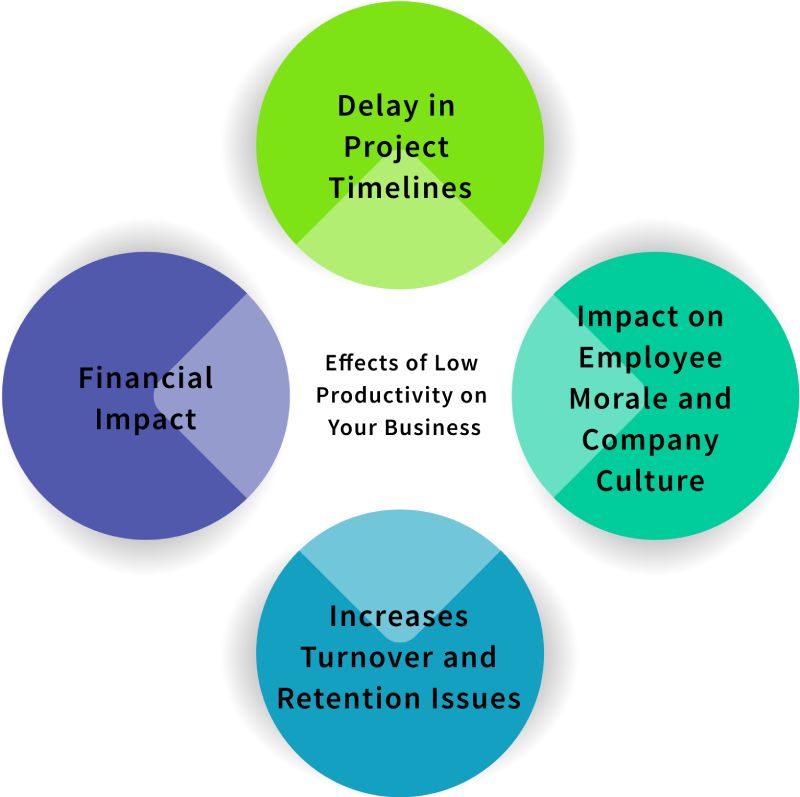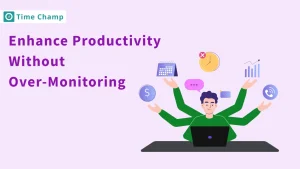Why does low productivity continue to plague your business despite your best efforts? It’s more than just missed deadlines, it can impact profits, employee morale, and even customer satisfaction. The hidden costs of lost productivity can quietly erode the foundation of your business if left unchecked. But the good news is, it’s fixable. In this article, we’ll explore how low productivity affects your business and the steps you can take to turn it around.
Relationship Between Productivity and Business Growth
Productivity is the key driver in business growth as it directly affects a company’s output of delivery of quality products and services. With high productivity, businesses can do more with less and meet ever-increasing output and profitability with the same and often fewer resources. This efficiency fosters innovation, expands offerings, and enhances responsiveness to market demands. Low productivity, on the other hand, limits capacity raises costs, and undermines competitive advantage. Hence, productivity needs to be encouraged for sustainable growth and long-term success.
Effects of Low Productivity on Your Business
Actively disengaged employees lead to an astonishing $1.9 trillion in lost productivity in the U.S., with only about 33% of the workforce being actively engaged. This disconnect highlights a significant issue that can hold businesses back from reaching their full potential. In this section, we’ll delve into how low productivity impacts your business and the broader implications for your organization.

Delay in Project Timelines
Low productivity causes late deadlines or delays in a project. For example, when a team member is taking much more time to complete tasks, the whole project may go slow. It not only affects internal timelines but also affects the relationship with the client. A delayed project may lead to losing business opportunities, such as losing more business from an unhappy client because of delays. As time prolongs to complete the project, the cost of time and resources hurts the capacity of the company to take on more projects.
Impact on Employee Morale and Company Culture
A decreased productivity in work environment can quite down the morale of employees and the culture at the workplace. When employees feel that their hard work goes unnoticed or when they are caught in a cycle of inefficiency, they may become discouraged. Then it leads to disengagement when the employee loses interest and contributes less to the team.
A negative work environment creates resentment among team members and leads to conflict between individuals. As relationships break down, employee productivity naturally declines, making the workplace even more toxic. It’s crucial to identify and address these problems to encourage a positive and productive environment.
Increases Turnover and Retention Issues
Low productivity can result in higher turnover, as workers who are consequently stressed or overtaken by work may leave for more promising opportunities. Workers often start looking for jobs in companies that can grant them more resources or even better working conditions when they feel unsupported or overwhelmed. This results in higher turnover rates, forcing the company to spend more time and money hiring and training new employees.
In addition to turnover, employee retention becomes a significant issue. The workers remaining may become frustrated with the revolving door in the workforce or by having to pick up the slack of their less productive team members. With workload on the rise and tension escalating, even the most dedicated workers may start looking for an exit as well. High turnover is not just a problem with a team. It will also slow down the overall performance because a newly hired workforce needs time and energy to adapt and get up to speed.
This even creates the reputation of a poor employer when a business suffers from turnover and retention issues. Consequently, it makes it difficult to attract the best talent for a business which, in turn, creates a cycle of productivity issues and staff losses that create long-term problems for a business.
Financial Impact
Slow productivity directly affects the revenues of the firm. Where employees are taking much longer than required to complete specific tasks, costs of operations increase because more time, labor, and resources are used. For instance, if a software development team takes its own time to complete a project, then probably the company will have to incur overtime or hire more staff to ensure that the work is completed on time, which nibbles into the margins of profitability. These extra costs add up, leaving the company with higher costs and reduced profitability.
In addition to higher costs of operations, poor productivity may also result in lost revenue. For example, if a marketing agency is delayed in completing a project, will lose new clients or prime contracts. Long term, the company will suffer from the consequences of delays and inefficiency in managing both active projects as well as potential new business. Higher expenses and lost opportunities together create a pileup that can limit the financial performance of the company, sometimes leading to stagnation or even a decline in revenue growth.
Also Read: Uncovering the causes of low productivity at workplace
Proven Strategies to Combat Low Productivity
“Productivity is never an accident. It is always the result of a commitment to excellence, intelligent planning, and focused effort.” – Paul J. Meyer. This quote underscores the importance of deliberate action in overcoming challenges. In this section, we’ll discuss proven strategies to combat low productivity and foster a culture of excellence within your organization.

Implement Clear Goal-setting
- The most obvious way of combating decreased productivity is setting clear goals for your employees which will clearly state the objectives of work and give them a sense of purpose in working.
- It is easier to track the activity of employees when their goals are specific, measurable, achievable, relevant, and time-bound.
- The use of SMART goal setting allows for breaking down even larger objectives into manageable and smaller steps that make progress toward that goal increasingly visible and rewarding.
- Well-defined goals will avoid confusion and assure all members of the team are working toward the same outcome, which in turn lowers wasted time.
- For example, when a team has a deadline to submit a project, then it can break work into lesser tasks, thus helping to adhere to the deadlines better and reduce bottlenecks.
Utilize Time Management Tools
- Implementing time management tools is one of the most effective ways to improve team productivity. These tools allow employees to track their tasks and optimize their time efficiently.
- A time tracker, or project management software, helps your employees understand exactly where the wastage of time is happening and make real-time adjustments to stay on track.
- Time management tools help employees set priorities by ensuring that the most important work is done first and therefore leads to an effective use of their workday.
- Simultaneously, the usage of time-tracking tools enables the eradication of time-wasting habits and ensures that the teams are prioritizing important tasks, leading to better productivity.
- For example, time-tracking software allows you to track the real-time workflow of your team, so no minute goes to waste on unproductive activities.
Improve Employee Engagement
- Keeping the employees engaged is majorly important in fixing low productivity. If the employees are attached to their work, they are very likely to be motivated and contribute to the team.
- Providing regular feedback and appreciating the work would boost morale and raise output levels.
- Through career growth opportunities and employee involvement in decisions, can create a positive work environment where productivity thrives.
- Obsession with the development of employee engagement in a company leads to better results, fewer absentees, and more innovative work.
- Studies show that companies with highly engaged employees are 17% more productive than those with low engagement, showing how important it is to keep employees motivated and aligned with company goals.
Providing the Right Resources and Training
- Employees face low productivity mainly because they lack the necessary tools and training, they need to work well.
- Providing up-to-date software and ongoing training helps employees feel confident and capable of completing tasks on time.
- Regular training programs keep employees informed about the latest industry trends, which helps them avoid mistakes and increases productivity.
- For example, training sessions about new software or techniques in and out would provide employees with skills to do their work more effectively.
- When employees are not provided with essential skills or tools, they might become frustrated with their work hence inefficiency in work also.
- Workers receive the correct tools along with the correct training the workforce can find an appropriate way of handling their workload, which in turn will impact the organization’s performance as well as the satisfaction of work.
Foster a Culture of Accountability
- Accountability culture enhances productivity. When employees feel that they are being held responsible for their actions and outputs, they do not divert their focus from work since they are motivated to achieve their goals.
- The expectations are well set and get checked in regularly so that everyone is aware of their roles, thereby reducing confusion and errors.
- Accountability enhances the performance of a team, in large part because employees take ownership of their work.
- This approach also minimizes the likelihood of missing deadlines and making mistakes, as it makes sure the employees are very careful about completing their work on time and to their abilities.
- Creating a trust and accountability culture results in building a strong, reliable, high-performing team that delivers successful results in the long term and brings consistent results.
Also Read: How to improve employee productivity in the workplace
Boost Productivity with the Help of Time Champ
Struggling to keep your business with low productivity is frustrating. But through Time Champ, you will find easy grounds to revamp things. This powerful tool is designed to help you track time, manage tasks, and streamline workflows, ensuring your team stays focused and efficient.
Productivity Tracking Software: Time Champ’s productivity tracking software provides comprehensive analytics on individual and team performance. By measuring output against time spent on various tasks, it offers valuable insights into where improvements can be made. This enables you to make data-driven decisions that enhance overall productivity and efficiency, ensuring your business thrives.
Automatic Time Tracking: No more logs of manual time entries. Time Champ automatically tracks how employees spend their time, giving detailed reports of their daily activities. This becomes the catalyst in helping managers understand time-wasting habits and empowers the teams to focus more on high-priority tasks. It makes sure that time is spent effectively without micromanaging.
Task Management: Time Champ helps organize work because it breaks down projects into tasks and allows easy assignment of tasks to other members of your team, enabling you to monitor their progress. This will help everyone know what they should do to clear the confusion and delay that might eventually come about. Thus, the teams can be clear and get their work done on time.
Employee Monitoring: In this, you get a view of how time is being utilized across the company and track employee activity, encompassing both idle time and productive hours. It allows you to encourage accountability and reassign resources where necessary to boost your efficiency. It also helps you point out patterns that slow down your productivity so that you can quickly adjust and maintain the smooth flow of things.
Reports and Insights: Detailed attendance reports, time spent on tasks, and overall productivity can enable managers to make quick and informed decisions. It helps in identifying bottlenecks and supports the running of projects in smoother processes. Regular reports also support ongoing improvement and better resource planning.
In short, Time Champ helps you streamline workflows, reduce inefficiencies, and foster a more productive work environment, making it a valuable tool for any business aiming to maximize its performance.
Conclusion
In essence, the bottom line for any business largely depends on productivity. Business leaders can create a more focused, motivated, and high-performing environment, by identifying challenges in efficiency and implementing thoughtful improvements. This leads to better results, increased employee satisfaction, and growth in the very short run. Commitment to enhancing productivity motivates long-term success and competitiveness in the marketplace.
Unlock your business’s full potential with Time Champ
Your solution for better productivity and faster results. Try it now!
Signup for FreeBook DemoFrequently Asked Questions
Low productivity refers to that situation where employees or teams are not working at full potential hence causing delays in low output and inefficient time and resource utilization. It mostly fails to meet deadlines and poor performance besides reduced profitability for business.
This might be defined by missed deadlines, frequent mistakes, longer periods than supposed to complete a task, and employees who don’t care or just seem to be demotivated. Others are poor communication, lack of focus in personal and project workflows, and other bottlenecks.
Businesses can use tools like time-tracking software, project management apps, and employee monitoring systems, to track the progress of work and how resources are being used to reduce areas of unnecessary waste of time. Such tools help manage tasks, determine priorities, and enhance overall productivity.
The reasons why remote workers can be less productive due to distractions, lack of structured schedules, and poor communication. Organizations should set some clear goals, regular checking in, time-tracking tools, and enhance communication to stay focused and efficient in remote working teams.






